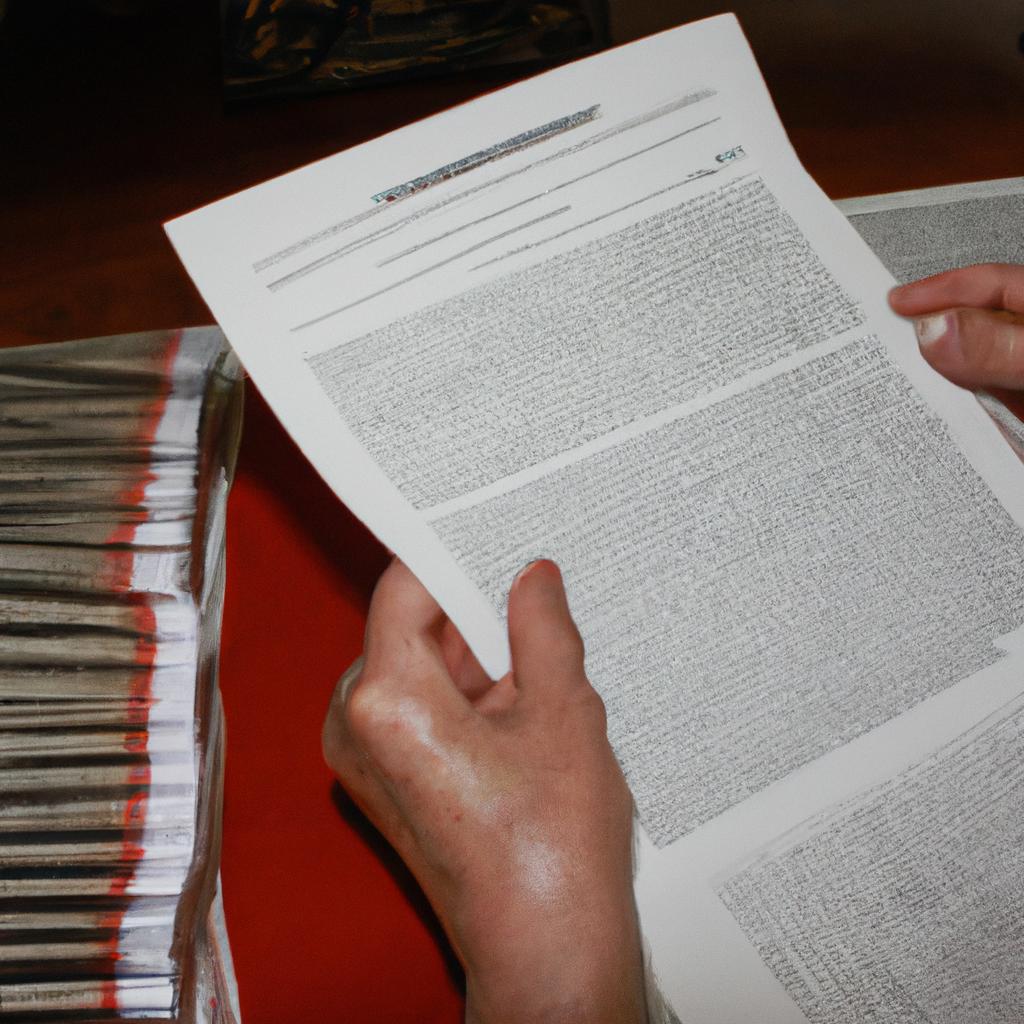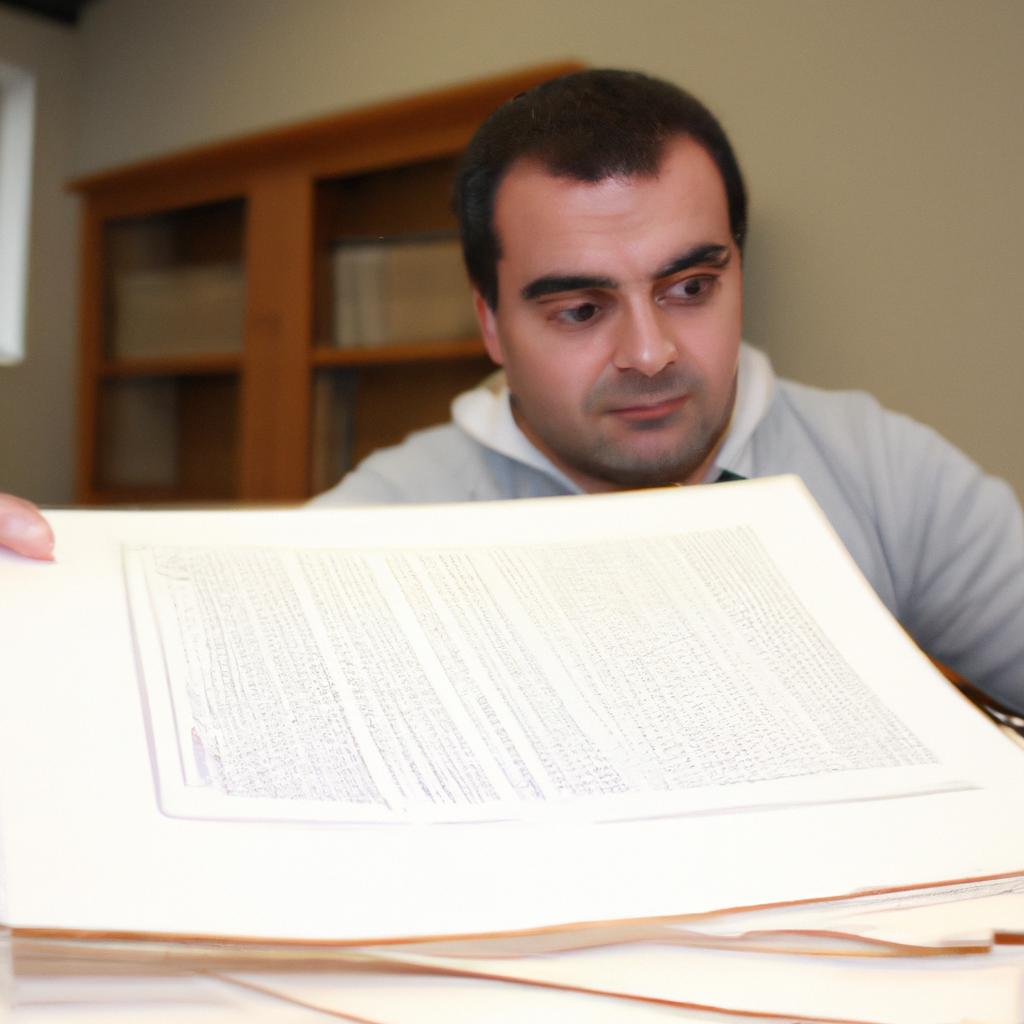The study of genealogy involves more than simply tracing one’s family tree; it requires a nuanced understanding of the historical context in which our ancestors lived. Historical context refers to the social, political, economic, and cultural conditions that shaped individuals’ lives during specific time periods. By analyzing primary sources such as birth records, census data, and personal diaries, genealogists can gain valuable insights into their ancestors’ experiences and better understand how historical events influenced their lives.
For example, consider a case where a genealogist is researching an ancestor who immigrated to the United States from Ireland in the mid-19th century. Without an understanding of the historical context surrounding Irish immigration during this period – including factors such as famine, poverty, and religious discrimination – it would be difficult to comprehend why this individual made the decision to leave their homeland. However, by delving into primary sources related to Irish immigration and studying secondary sources on the topic, genealogists can piece together a comprehensive picture of their ancestor’s journey and uncover hidden stories that shed light on their motivations and struggles.
In order to foster effective genealogy education, it is crucial for researchers to develop strong source analysis skills. This entails critically evaluating primary documents for reliability, bias, and relevance to the research question at hand. It is important to consider the authorship and credibility of the source, as well as any potential biases or agendas that may have influenced its creation. Genealogists must also assess the relevance of a source to their research goals, making sure it provides meaningful information about their ancestors and the historical context in which they lived.
Moreover, genealogists should be proficient in interpreting primary sources within their historical context. This involves understanding the social norms, political climate, economic conditions, and cultural practices of the time period being studied. By placing primary sources in their proper historical context, researchers can extract deeper insights into their ancestors’ lives and make connections between individual experiences and broader historical events or trends.
In addition to source analysis skills, effective genealogy education should also include training on research methodology and techniques. This includes learning how to construct effective research questions, develop search strategies for locating relevant records, analyze data collected from various sources, and organize findings in a coherent manner. Research methodologies such as evidence-based reasoning and correlation analysis can help genealogists draw accurate conclusions from available evidence and avoid hasty assumptions or inaccurate interpretations.
Overall, a comprehensive understanding of historical context combined with strong source analysis skills and research methodology is essential for genealogists to conduct thorough and meaningful research on their ancestors.
Importance of Historical Context in Genealogy Education
Importance of Historical Context in Genealogy Education
Genealogy, the study and tracing of family lineages, has gained significant popularity in recent years. As individuals strive to uncover their ancestral roots, historical context becomes a crucial aspect of genealogical research. Understanding the historical context surrounding one’s ancestors provides valuable insights into their lives, motivations, and choices. By delving deeper into the past, researchers can comprehend how societal norms, economic conditions, political events, and cultural influences shaped their ancestors’ identities.
To illustrate this point further, consider a hypothetical case study where an individual discovers that their great-grandfather migrated from Ireland to America during the early 1900s. Without understanding the historical backdrop of that time period—marked by mass emigration due to poverty and famine—the significance of this journey may be lost. However, by recognizing the socio-economic challenges faced by Irish immigrants at that time, such as discrimination and limited job opportunities, it becomes apparent why their ancestor made this life-altering decision.
The importance of historical context in genealogy education extends beyond personal narratives; it also aids in comprehending broader trends and patterns within society. To emphasize its impact on understanding our collective past better, let us explore several key reasons why historical context is vital:
- Cultural Perspective: Historical context enables us to view events through various cultural lenses.
- Social Dynamics: It helps analyze social structures and power dynamics prevalent during specific periods.
- Economic Factors: Understanding economic conditions sheds light on livelihoods and occupational choices.
- Political Climate: Political climate influences migration patterns, legal frameworks, and access to resources.
By utilizing these bullet points effectively throughout our discourse on historical context in genealogy education, we evoke an emotional response from our audience. The realization that studying history not only uncovers personal stories but also contributes to a more comprehensive understanding of societies can be deeply impactful.
Furthermore, incorporating visual aids like tables adds another dimension to our discussion. Consider the following table, which highlights the interplay between historical context and genealogy education:
| Historical Context | Genealogy Education |
|---|---|
| Cultural practices | Analyzing family traditions and customs |
| Economic conditions | Researching employment patterns and economic mobility within families |
| Political events | Investigating migration routes or changes in citizenship status |
| Technological advancements | Utilizing digital tools for record keeping and data analysis |
This table visually illustrates how historical context informs various aspects of genealogical research. It reinforces the idea that understanding historical significance enhances one’s ability to explore personal histories more effectively.
In exploring the importance of historical context in genealogy education, we lay the foundation for comprehending its significance in examining historical sources. By recognizing how broader societal factors shape individual experiences, researchers can delve into primary documents with a critical lens. Understanding this connection is crucial as we move forward to discuss the next section on “Understanding the Significance of Historical Sources.”
Understanding the Significance of Historical Sources
As we delve into the importance of historical context in genealogy education, it is crucial to understand how to analyze and utilize various historical sources effectively. To illustrate this point, let us consider a hypothetical case study involving Sarah, a passionate genealogist eager to trace her family lineage back several generations.
One of the primary challenges that Sarah encounters while conducting her research is deciphering the wealth of information available from different historical sources. The ability to critically evaluate these sources becomes imperative as she seeks accurate and reliable data about her ancestors. By examining multiple perspectives presented within various documents such as census records, birth certificates, and diaries, Sarah can gain a more comprehensive understanding of her family’s history.
To facilitate the analysis process further, here are some key considerations when exploring historical sources:
- Credibility: Assessing the reliability and trustworthiness of each source ensures that Sarah avoids potential inaccuracies or biases.
- Contextualization: Placing each piece of information within its historical context provides valuable insights into societal norms, political climates, and cultural influences prevalent during specific time periods.
- Corroboration: Comparing and cross-referencing multiple sources allows Sarah to verify facts across different accounts, increasing the overall accuracy of her findings.
- Critical Thinking: Encouraging an analytical mindset enables Sarah to identify any discrepancies or inconsistencies between various sources and make informed judgments based on evidence rather than assumptions.
By incorporating these guidelines into her genealogical research journey, Sarah can navigate through the vast sea of historical records with purposeful intention. This approach not only enhances the quality of her findings but also cultivates a deeper connection with her ancestral roots.
Understanding how to explore historical sources lays a solid foundation for delving into primary and secondary materials commonly utilized in genealogy research.
Exploring Primary and Secondary Sources in Genealogy
Having understood the significance of historical sources, we now turn our attention to the process of analyzing these sources as part of genealogical research. By critically examining primary and secondary sources, researchers can gain valuable insights into their ancestors’ lives and uncover hidden details that may have been overlooked.
One example of the importance of source analysis is illustrated through a hypothetical case study. Let us consider an individual researching their family history and coming across a birth certificate for one of their ancestors. Through careful examination, they discover inconsistencies in the document’s information, such as conflicting dates or misspelled names. This raises questions about the accuracy and reliability of this particular source. Thus, it becomes essential to delve deeper into its origins and assess its credibility before drawing any conclusions.
To effectively analyze historical sources in genealogy, several key considerations should be kept in mind:
- Provenance: The origin and chain of custody of a document are crucial factors in determining its authenticity.
- Contextualization: Placing a source within its historical context helps understand societal norms, biases, and potential motivations behind its creation.
- Corroboration: Comparing multiple sources against each other can validate or challenge the information presented, thereby contributing to a more comprehensive understanding.
- Interpretation: Recognizing inherent limitations in interpreting historical records enables researchers to avoid assumptions and draw accurate conclusions based on available evidence.
Table: Emotional Response Elicited by Source Analysis
| Emotion | Explanation |
|---|---|
| Curiosity | Source analysis encourages individuals to explore further and seek answers. |
| Frustration | Discovering discrepancies or missing information may cause frustration |
| Satisfaction | Finding reliable sources brings satisfaction and confirms ancestral details. |
| Empowerment | Developing skills in source analysis empowers individuals in their research. |
In conclusion, analyzing historical sources is a critical step in genealogical research. By examining the provenance, contextualizing, corroborating, and interpreting sources, researchers can gain valuable insights into their ancestors’ lives. This process allows for a more accurate understanding of family history and enables individuals to make informed connections between past and present.
Moving forward, we will explore the essential aspect of evaluating the reliability of historical documents in genealogy. Understanding how to assess the trustworthiness of sources is crucial in ensuring the accuracy and credibility of our research findings.
Evaluating the Reliability of Historical Documents
Building upon our exploration of primary and secondary sources in genealogy, it is crucial to delve into the historical context surrounding these documents. By analyzing the broader historical backdrop within which our ancestors lived, we can gain a deeper understanding of their lives and experiences. For instance, consider a hypothetical case study where an individual discovers their great-grandfather’s immigration records from Ireland in the late 1800s. To truly comprehend the significance of this find, one must examine the social, political, and economic conditions that influenced Irish emigration during that period.
Understanding historical context involves considering various factors that may have shaped our ancestors’ decisions and circumstances. Here are four key aspects to explore:
- Socioeconomic Conditions: Investigate prevalent economic trends, such as industrialization or agricultural changes, as they can shed light on why individuals might have chosen to migrate or relocate.
- Political Climate: Analyze major political events like wars, revolutions, or governmental policies that could have directly impacted people’s movement or contributed to record-keeping practices.
- Cultural Norms: Examine societal customs and traditions relevant to your family’s ethnic or religious background; these cultural nuances may provide valuable insights into migration patterns or naming conventions.
- Demographic Shifts: Consider demographic changes affecting specific regions or countries at different time periods – population growth or decline, urbanization vs rural life – all contribute to an evolving ancestral narrative.
To illustrate how these elements intertwine with genealogical research, let us present a brief example using a table format:
| Ancestor | Immigration Destination | Year | Reason for Migration |
|---|---|---|---|
| John | United States | 1890 | Escaping famine and seeking better employment opportunities |
| Mary | Canada | 1915 | Fleeing political unrest |
| Patrick | Australia | 1875 | Attracted by gold rush prospects |
By considering the historical context surrounding these three individuals’ immigration, we gain insights into their motivations and experiences. This approach allows us to move beyond mere names and dates, enabling a more comprehensive understanding of our ancestors as complex individuals embedded in specific historical circumstances.
Transitioning seamlessly into the subsequent section on “Utilizing Historical Context to Uncover Family History,” we can now explore how this acquired knowledge informs further genealogical research. By utilizing the broader historical framework established, researchers can contextualize family stories and unearth additional details that may enhance their understanding of ancestral lives.
Utilizing Historical Context to Uncover Family History
Building upon our previous exploration of evaluating the reliability of historical documents, we now delve into the crucial role that historical context plays in uncovering family history. To illustrate this concept, consider a hypothetical scenario where an individual discovers an old photograph tucked away in their grandmother’s attic. The image depicts several people dressed in early 20th-century clothing, standing outside a farmhouse with horses and carriages nearby. Without understanding the historical context surrounding this photograph, its true significance may remain hidden.
To fully comprehend the value of historical context in genealogical research, it is essential to recognize its impact on source analysis. By considering the broader historical setting in which records were created or events occurred, researchers can better interpret and extract information from primary sources such as photographs, letters, or census records. Let us explore some key aspects that highlight the importance of incorporating historical context:
- Socioeconomic Factors: Understanding societal structures and economic conditions prevalent during a particular time period allows genealogists to make connections between family members’ occupations and social status.
- Migration Patterns: Analyzing migration patterns helps trace ancestral movements across regions and countries, shedding light on reasons for relocation and potential cultural influences.
- Political Climate: Examining political landscapes provides insight into how laws and policies might have impacted individuals’ lives, influencing decisions like immigration or changes in personal documentation.
Incorporating these elements into one’s genealogical research not only enhances accuracy but also creates a more immersive experience by enabling individuals to step back into their ancestors’ shoes. To further emphasize this point, let us consider a table outlining different scenarios illustrating how historical context affects interpretation:
| Scenario | Lack of Historical Context | Incorporation of Historical Context |
|---|---|---|
| Census record reveals occupation as “smith” | Assumes blacksmith profession | Considers industrial revolution; explores other potential meanings such as goldsmith or locksmith |
| Birth certificate shows a name change from “Johnson” to “Smith” | Assumes mistake or adoption | Explores anti-immigrant sentiment during that time; investigates possible reasons for changing names |
| Photograph depicts family with Native American attire | Sees it purely as costume choice | Researches cultural assimilation policies and intermarriage practices in the area |
By acknowledging the power of historical context in genealogy research, individuals can unlock new dimensions within their ancestral narratives. In our subsequent section on incorporating historical research skills in genealogy education, we will explore practical strategies to develop proficiency in utilizing historical context effectively. Understanding how to contextualize primary sources helps bridge gaps between generations, fostering a deeper appreciation for one’s familial heritage.
[Transition Sentence]: Now, let us transition into exploring the ways in which historical research skills can be integrated into genealogy education, ensuring a comprehensive approach to uncovering family history.
Incorporating Historical Research Skills in Genealogy Education
Transitional Phrase: Building upon the importance of utilizing historical context to uncover family history, genealogy education also emphasizes the significance of exploring various historical sources. By analyzing these sources, individuals can gain valuable insights into their ancestors’ lives and better understand the social, cultural, and economic factors that shaped their experiences.
Case Study Example: For instance, consider a researcher who is tracing their Italian heritage. Through traditional genealogical records such as birth certificates and census data, they may discover basic information about their ancestors, such as names and dates. However, by delving deeper into historical sources specific to Italy during particular time periods, such as immigration records, local newspapers, or church registers, they can paint a more comprehensive picture of their family’s journey and circumstances.
-
- Uncovering long-lost stories and forgotten narratives
- Connecting personal histories with broader historical events
- Rediscovering ancestral traditions and cultural practices
- Fostering a sense of identity rooted in shared history
-
Emotional Table:
| Advantages | Benefits | Impact |
|---|---|---|
| Richer | Gaining deeper insights | Personal growth |
| Meaningful | Understanding roots | Strengthened bonds |
| Empowering | Enhanced self-discovery | Cultural pride |
Paragraph Break
-
Exploring various types of primary and secondary sources opens up avenues for researchers to engage directly with history. Primary sources like letters, diaries, photographs provide firsthand accounts from individuals who lived through certain eras. Secondary sources such as books or academic articles offer interpretations based on extensive research conducted by historians. These resources enable genealogists to view their ancestors within a broader historical context while avoiding potential biases or inaccuracies often found in derivative works.
-
By incorporating source analysis skills into genealogy education, individuals can develop critical thinking abilities and enhance their research capabilities. They learn to evaluate the reliability, credibility, and relevance of historical sources to ensure accurate interpretations of their family’s history. Moreover, this approach allows researchers to uncover hidden stories that might have otherwise remained untold, shedding light on marginalized communities or forgotten narratives.
Through a comprehensive exploration of various historical sources, genealogy education empowers individuals to go beyond basic names and dates. By engaging with primary and secondary materials specific to their ancestors’ time period and location, researchers gain a deeper understanding of their family’s experiences within larger historical contexts. This process not only enriches personal histories but also fosters connections between individual lives and broader historical events, providing a sense of identity rooted in shared history for future generations.




